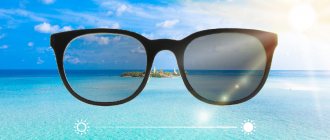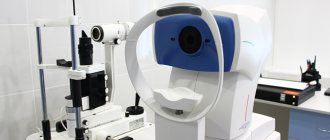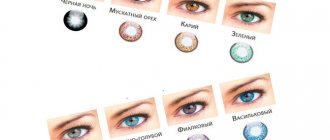Most people who wear glasses often experience discomfort when the weather gets sunny. This problem especially concerns people who drive a car or spend a lot of time outside.
An excellent summer solution for people with poor vision will be sunglasses with diopters
. These are two-in-one glasses: vision glasses and sunglasses at the same time. In addition to ensuring a comfortable stay in the blinding sun, such glasses protect against harmful UV radiation and have a number of other advantages.
What do prescription sunglasses look like?
Everyone wants to look beautiful, and many who wear glasses often dream of fashionable sunglasses, which they cannot wear due to poor eyesight. Fortunately, prescription sunglasses look no different from regular sunglasses. You can choose branded ready-made sunglasses and change the lens, or add dark lenses to your regular frame. Modern technologies allow you to choose almost any frame of your choice, provided that the frame material and prescription allow you to insert lenses into it.
conclusions
Prescription sunglasses are a good alternative to regular glasses for vision and sun protection, since they solve both problems at the same time. Lens and frame materials may vary. There are about 70 color options for the design of lenses; coloring can be done in the factory or in an optical shop (the first option is more expensive, but more reliable). Don't forget that the color of the glasses has nothing to do with the level of protection - dark lenses will only be effective if they have a polarizing coating. Protection levels are from 0 to 4, each type of activity requires different glasses (only chameleon models are a universal option). For driving, you should select models with a special anti-reflective coating.
Also read about what glasses with holes are, what models of computer glasses are available, and who suits round glasses.
What lenses can be inserted into sunglasses for vision?
The choice of lenses for sunglasses should be approached very carefully. What should you pay attention to when choosing sun lenses?
- Lens material.
Today, leading manufacturers make lenses from polymer materials, i.e. plastic. Such lenses are lighter, more practical and safer.
- UV protection
. It is very important to understand that the sun protection lens must have a filter that blocks harmful UV radiation. There is a misconception that the darker the glasses, the better the protection - this is not true. The degree of darkness does not affect the presence of a filter in any way. All tinted spectacle lenses in Optic Center salons have this UV filter, so you don’t have to worry about your eye health.
- Painting and color
. There are two fundamentally different types of coloring for spectacle lenses. The first option, for more economical users, is to color the lens in optical conditions. In this way, you can paint lenses with absolutely any intensity and color, and even make a gradient transition. However, with this coloring the shade may differ slightly from the sample. The second option is ready-made colored lenses from the manufacturer. This coloring is done in laboratory conditions, which allows you to choose a wider range of palettes. In addition, lenses from the manufacturer are coated with an anti-reflective and strengthening coating, as well as a polarizing layer that eliminates bright glare from reflective surfaces. Such lenses do not fade and last much longer. And unlike painting yourself, the color of the lens can be viewed and selected from specific samples. Available in over 70 color options, including gradient and mirror finishes.
Choosing spectacle lenses with diopters for your sunglasses
Sooner or later, any user of medical glasses wonders about a second pair of sun lenses. Of course, with their own diopters and sufficient tinting to protect against bright light. As you already understood, we will talk about sunglasses with diopters. Many people find a solution to this issue by using photochromic lenses in their frames or in a model from a sunglasses collection. Photochromic glasses are very comfortable and most importantly they can be used in any weather. But this option cannot be called a budget option; photochromic lenses are quite expensive. A more affordable option for creating second glasses is to use ready-made sun lenses with diopters - already tinted (painted) at the factory in the most popular colors. We present a truly interesting offer in this segment of spectacle lenses.
Go to the “Eyeglass Lenses” page.
German spectacle lenses Starvision, which is a subsidiary brand of the famous company SEIKO Optical, have in their assortment three types of tinted spectacle lenses with diopters. The simplest and most affordable option is Starvision JetStar SUN 1.50 UC sunglasses lenses. They are produced in diopters from -5.00 dpt to +5.00 dpt, which covers the needs of the vast majority of medical glasses prescriptions. Users with astigmatism are also not forgotten! The production area covers all astigmatic prescriptions with cylinder readings up to 2.00 diopters.
Starvision JetStar SUN 1.50 UC sun protection lenses are available in three colors: Sun Grey, Sun Brown and Sun Green. The first two colors offer a choice of two tint levels: 75% (slightly visible eyes) or 85% (classic sunscreen), while the dark green color is only available in the 85% option. The diameter of spectacle lenses from the most common diopters is large enough to install them in any medical glasses frame or in most classic sunglasses.
The second type of sun lenses with Starvision JetStar SUN 1.50 HSC inner diopters is an analogue of the first type with improved visual characteristics. The inside of these spectacle lenses has a multi-layer multi-coating, which significantly improves the quality of vision in sunglasses. Such lenses are usually installed in branded sunglasses. Multi-coating consists of three main layers: HardCoat - protects the surface of the spectacle lens from minor scratches; AR-Coat - multi-layer anti-reflective coating that reduces glare; CleanCoat is a dirt-water-grease-repellent coating that makes cleaning lenses easier. The tinting colors and diopter production area fully correspond to the first type. The difference in price between the first and second types of spectacle lenses is not great, so our recommendation is to use Starvision JetStar SUN 1.50 HSC inner, as an option that provides better vision.
The third type of lenses for sunglasses - Starvision JetStar SUN 1.60 HSC inner are German spectacle lenses made of “thin” optical material n=1.60 with multi-coating on the inside. If the first two types could be recommended for diopters up to +/- 2.50 dpt, then the third type Starvision JetStar SUN 1.60 HSC inner can be used for higher diopters. The effective use of spectacle lenses with a refractive index of 1.60 covers diopters from - 4.50 dpt to + 4.50 dpt. With these diopters, the finished design of sunglasses will look quite aesthetically pleasing. But, if your dioptres are higher, don't worry - the Starvision JetStar SUN 1.60 HSC inner is produced from -8.00 dpt to +6.00 dpt, with a cylinder up to 2.00 dpt.
Another important advantage of the Starvision JetStar SUN 1.60 HSC inner sun lenses is their high strength. Optical material 1.60 has significant elasticity and is certainly superior to lenses made from material 1.50 in terms of reliability under shock loads. Therefore, if you are planning to install sun lenses in a rimless design, with lenses mounted on screws or on a fishing line, then your choice should definitely be the third type.
The Starvision company has formed a large European warehouse of colored lenses in Germany and quickly delivers them to Russia, Kazakhstan and Belarus. Delivery time takes only 7-10 days. So, you can expect to get prescription sunglasses in a short period of time.
Photo: opticbox.ru seiko-lens.ru
Which vision sunglasses are best for driving?
The most functional sunglasses option for drivers are Nupolar tinted polarized lenses. Glasses with such lenses not only protect your eyes from the bright sun, but also eliminate glare on the car windshield.
There are also special lenses for drivers - Drivewear, they provide maximum quality of vision while driving in any weather - sunny, cloudy or foggy. Such lenses not only remove glare from the windshield, wet asphalt and “dispel fog”, but also adapt to the level of illumination: in cloudy and foggy weather the lenses have an olive tint; in the blinding sun the lenses become intensely brown.
Many drivers know about the so-called chameleon glasses, or, as they are correctly called, photochromic glasses. These glasses replace two pairs at once: vision glasses and sunglasses; they darken outdoors and remain light indoors, thus providing comfortable vision in any light. It is worth noting that some of these lenses, for example Transitions ExtraActive, darken even behind the windshield, as they react not only to UV radiation, but also to visible light.
Types of sunglasses with diopters
The most common vision-correcting sunglasses are tinted and darkening. At the same time, the degree is divided into 5 levels:
- level “0” – glasses that transmit 80-100% of light, intended for use with increased image contrast in brightly lit rooms, used in light sunny weather;
- level “1” – glasses that transmit 43-80% of light and can be used in light sunlight in urban environments;
- level “2” – glasses transmitting 18-43% of light, used in the city;
- level “3” – transmits 8-18% of light, designed to be worn in bright sun, on the beach and protects the eyes from damage;
- level “4” - transmits 3-8% of light, intended for being in places where there is a lot of bright light, for example, at sea or in the mountains.
No less convenient and versatile in terms of vision protection and correction are the so-called photochromic glasses. Their peculiarity is the change in the degree of darkening under the influence of ultraviolet rays. When a person is indoors, the minimum degree of darkening is used, but when going out into sunlight, the lenses instantly darken, that is, the degree of darkening increases.
When choosing photochromic glasses, you should pay attention to some nuances:
- Photochromic glasses darken under the influence of ultraviolet rays, so they are not intended for driving;
- in the cold the action of photochromic agents is faster than in the heat, therefore in the cold season there is a rapid change in the degree of darkening;
- Photochromic glasses lose their darkening properties over time, so it is necessary to periodically replace the lenses with new ones.
How much do vision sunglasses cost?
Specialists at Optic-Center salons will help you choose the right option that suits not only your lifestyle, but also your financial capabilities.
- a more budget-friendly option for having lenses painted by craftsmen in a salon will cost 1,000 rubles for two lenses (including coloring);
- sun lenses in stock - 950 rubles per piece. (brown and gray, from 0.00 to -5.00 diopters);
- colored lenses from the manufacturer - from 1800 rubles per piece. (wide range of colors and diopters).
The final price for glasses will depend on the frames you choose, the lenses and the complexity of your prescription.











